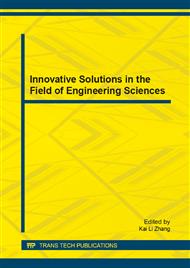[1]
P. Joseph, L. Jacob, Automated aerial refueling: extending the effectiveness of unmanned air vehicles, AIAA Modeling and Simulation Technologies Conference and Exhibit, San Francisco, AIAA. (2005) 6005-6013.
DOI: 10.2514/6.2005-6005
Google Scholar
[2]
H. Jacob, S. Daniel, Automated aerial refueling presentation to 2007 aerial refueling systems advisory group conference, Las Vegas: Air Force Research Laboratory. (2007) 1-18.
Google Scholar
[3]
X.M. Dong, Y.J. Xu, B. Chen, Progress and challenges in automatic aerial refueling, Journal of Air Force Engineering University (Natural Science Edition). (2008) 1-5.
Google Scholar
[4]
J.M. White, After the KC-135, what next? exploring the future capabilities and acquisition of our next generation tanker, Air University. (2002).
Google Scholar
[5]
C. Boklcom, Air force aerial refueling methods: flying boom versus hose-and-drogue, RL32910, The Library of Congress. (2006).
Google Scholar
[6]
L. Pollini, G. Campa, F. Giulietti, et al. Virtual simulation set-up for UAVs aerial refueling, AIAA Modeling and Simulation Technologies Conference and Exhibit, Austin, AIAA. (2003) 11-14.
DOI: 10.2514/6.2003-5682
Google Scholar
[7]
R. Mati, L. Pollini, A. Lunghi, et al. Vision based autonomous probe and drogue aerial refueling, AIAA Modeling and Simulation Technologies Conference and Exhibit, San Francisco, AIAA. (2005) 15-18.
DOI: 10.2514/6.2005-6010
Google Scholar
[8]
W.R. Williamson, M.F. Abdel-Hafez, I. Rhee, et al., An instrumentation system applied to formation flight, IEEE Transactions on Control Systems Technology. 15 (2007) 75-85.
DOI: 10.1109/tcst.2006.883241
Google Scholar
[9]
J.L. Hansen, J.E. Murray, N.V. Campos, The NASA dryden AAR project: a flight test approach to an aerial refueling system, AIAA atmospheric flight mechanics conference and exhibit. (2004) 2004-(2009).
DOI: 10.2514/6.2004-4939
Google Scholar
[10]
M. j. Vachon, R.J. Ray, C. Calianno, Calculated drag of an aerial refueling assembly through airplane performance analysis, 42nd AIAA Aerospace Sciences and Exhibit. (2004) 2004-381.
DOI: 10.2514/6.2004-381
Google Scholar
[11]
L. Itti, C. Koch, E. Niebur, A model of saliency-based visual attention for rapid scene analysis, IEEE Transactions on Pattern Analysis and Machine Intelligence. 20 (1998) 1254-1259.
DOI: 10.1109/34.730558
Google Scholar
[12]
Z. Li, L. Ltti, Saliency and gist features for target detection in satellite images, IEEE Transactions on Image Processing. 20 (2011) 2017-(2029).
DOI: 10.1109/tip.2010.2099128
Google Scholar
[13]
M.D. Tandale, R. Bowers, J. Valasek, Robust trajectory tracking controller for vision based probe and drogue autonomous aerial refueling, AIAA Guidance, Navigation and Control Conference and Exhibit. (2005) 2005-5868.
DOI: 10.2514/6.2005-5868
Google Scholar
[14]
C. Chao-I, S. Roger, Drogue tracking using 3D flash lidar for autonomous aerial refueling, Proceedings of Laser Radar Technology and Applications XVI, Florida. 8037 (2011) 1-11.
DOI: 10.1117/12.886572
Google Scholar
[15]
X.F. Wang, X.M. Dong, X.W. Kong, Feature recognition and tracking of aircraft tanker and refueling drogue for UAV aerial refueling, IEEE International Conference on Chinese Control and Decision Conference, Guiyang. (2013) 2057-(2062).
DOI: 10.1109/ccdc.2013.6561274
Google Scholar


